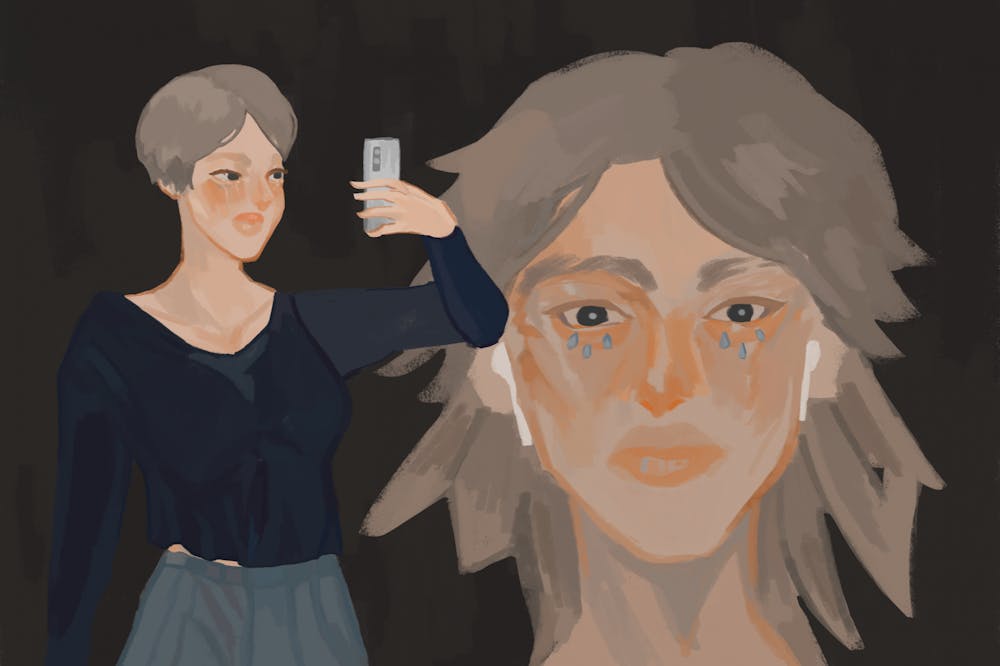One of Spotify’s most popular playlists is the “sad girl starter pack.” This corporation–curated mix shuffles between 75–or–so songs that depict varying degrees of melancholy. The songs here range from the intellectually moody (“God Turn Me Into a Flower” by Weyes Blood describes the social alienation of modern society) to the objectively sweet (“Kissing Lessons” by Lucy Dacus is a song about first crushes, and duh, first kisses). The theme here isn’t a unifying emotion, but rather the sort of meditative, vaguely chill mood this brand of indie pop creates.
The audience of this playlist is a new type of “it girl.” She’s the “sad girl,” an internet type of personality that Red Scare podcaster Dasha Nekrasova defined like this: “I’m definitely guilty of having Girl, Interrupted syndrome through my teens and early 20s, at least. Yeah, of being like, I’m so special and so tortured.”
The romanticization of female sadness is probably as old as art, but a new glamorously cool presentation of sadness is having a moment. It took some earlier internet forms in the early 2010s, when Lana Del Ray–esque, coquette–style Tumblr pages could get big numbers posting about being pretty when they cry. However, there are some changes in the aesthetic’s translation to 2023, which more than ever centers around consumerism and commodification.
It has become very common for young women online to express their personal identities through well–tailored lists of media that they consume. If a girl on your Tiktok page says she’s in her Joan Didion era, or her Normal People era, or her Fleabag era, or her Phoebe Bridgers era, or (god forbid) her Sylvia Plath era, she’s subtly signaling and guiding you through the roadmap of her own sadness. These stylishly curated collections of popular media are also some of the quickest ways to suggest hidden depth, and signify intellectual and social capital on the internet. By identifying with wounded women one can also signal their emotional and mental health struggles.
But much like the “sad girl starter pack,” these references aren’t really used to explore emotion; they instead provide an unchanging landscape, a melancholy background. It’s a static, self–perpetuating sadness that comforts rather than confronts. Perhaps songwriter Lucy Dacus, who has long been labeled a “sad girl,” said it best when she tweeted about her frustration with the term: “Sadness can be meaningful but I got a bone to pick with the ‘sad girl indie’ genre, not the music that gets labeled as that, but the classification and commodification and perpetual expectation of women’s pain, also I don’t think my songs are sad, anyways good morning.”
We do a great disservice to the artists we love when we deem their work “sad girl music/books/movies” because we stop valuing them on their own terms. But we’re doing worse to ourselves by transforming our own mental health struggles into labels and fragmented ideas. The positioning of sadness as a hot new product feeds the kind of corporate mindset which produces a “sad girl starter pack” playlist. It becomes a consumable kind of sadness—of which you can get premium for $9.99 a month! When sadness becomes cool, sadness sells.
However, this shouldn’t imply that “sad girl core” is an entirely sonic and visual trend: some critics have found political meaning in it, like artist and writer Audrey Wollen, who says that the act of female suffering is a protest against patriarchy. Yes, the inclusivity of female pain in art and public discourse is radical, but packaging complex emotions and pieces of art into easily consumable bits is anything but. Mental health struggles no longer exist as complex issues that warrant closer care and examination, but stickers and tags decorating a hot new product.
This commercialization of sadness erases depth from complex emotions and feelings, subsuming everything into a sea of vague and undefined melancholy. “Sad girl aesthetic” beautifies and simplifies mental health struggles, not to mention presents them as overwhelmingly white. This aesthetic has generally been conquered by white women, from Taylor Swift to Sally Rooney. If we start to mostly understand mental health struggles through white perspectives, this trend isolates more people than it helps.
There’s a capitalist mindset that drives this aesthetic forward; it works to reduce our painful feelings into small, consumable, and generally vibey ideas and internet trends that can be sold. This doesn’t just make you a commercial target, it makes you the product on display. The internet landscape commodifies your emotions, and then sells products shallowly oriented on mental health back to you. Emotional truth isn’t something you can really find online, and when the internet tells you that you can, it may be time to log off.
The current integration of mental health struggles into aspirational identity traits is deeply concerning. The sad girl aesthetic, as all aesthetics are, is ultimately all about how we want to present ourselves to the world. Are we donning the ‘sad girl’ title for some outward image of emotional depth?
It can be truly liberating and vulnerable to place your identity within a Taylor Swift song because you know someone else has felt these feelings and that you're not alone. But over–identification with this art keeps you in a box. It doesn’t let you feel—it tells you how to feel. The natural extension of this trend is a future in which the internet commercializes our feelings so much that we don’t know how we feel without it. And how will any of us know how to talk about our own feelings? How will anybody know how to understand their mental health if they haven’t yet filtered it through Netflix, or Spotify, or Tiktok?

